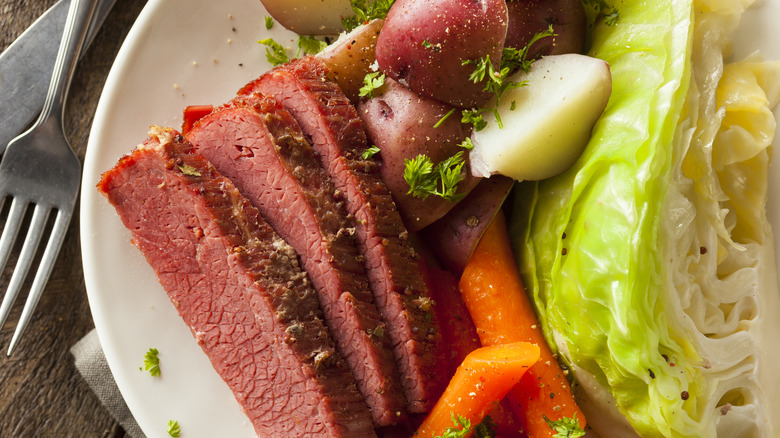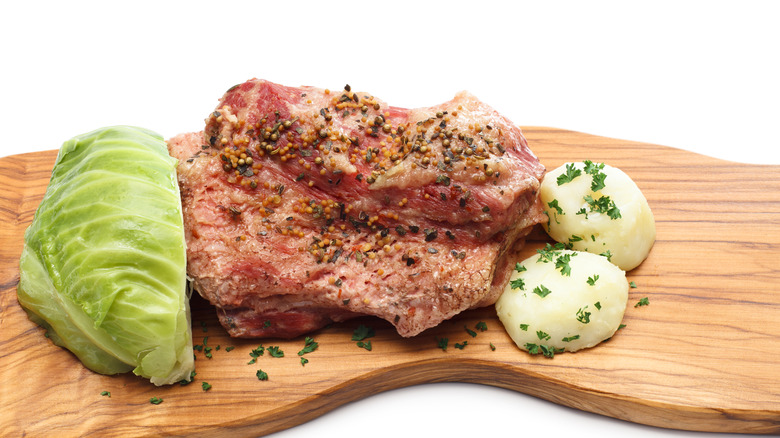How Corned Beef And Cabbage Became A New Years' Tradition
What you choose to eat on New Year's Day is serious business. After all, it can set the tone for your entire year, at least according to various (and sometimes contradictory) superstitions. From the Spanish tradition of eating twelve grapes in twelve seconds under a table, to the Southern American tradition of eating black-eyed peas for good luck in the upcoming year, food carries a new level of importance on the first day of the year.
One New Year's meal that's particularly popular among Irish Americans, or Americans who are Irish in spirit, and that's corned beef and cabbage. The meal, which is also often associated with St. Patrick's Day, is meant to help bring good fortune into the new year. Folks opt for corned beef or pork for this meal as chicken and fowl supposedly bring bad luck because they dig into the dirt for food. If you eat these birds on New Year's, it's said that you'll have to dig around searching for food in the new year too. As for the cabbage, well, cabbage is green like money, and therefore will attract wealth in the upcoming year. Or at least that is the stated reasoning behind the supposedly traditional Irish holiday meal.
But that's all just superstitions and old wives' tales; the actual history of the dish, and its role as a good-luck New Year's food, is a bit more complicated, and a lot less Irish than you might think.
A not-so-Irish tradition
For starters, corned beef — which is seemingly ubiquitous on holidays like St. Patrick's Day — is not all that Irish of a dish. Though corned beef was a popular export from Ireland in the 16th and 17th centuries, the meat was not all that commonly consumed among the Irish, according to Smithsonian Magazine. Instead, pork and ham were staples of the Irish diet, along with potatoes, of course. Beef was considered a luxury good to many Irish people, with cows being reserved for milk and dairy products, and only slaughtered if they became injured.
It wasn't until the Great Famine when over a million Irish immigrants fled to America that corned beef became associated with Irish identity. This is because, though pork was the less expensive option in Ireland, corned beef, popularly served in Jewish delis around New York City, was the more affordable option in America. Corned beef then became a popular meat among Irish immigrants, and is, therefore, more of an Irish-American tradition than being purely Irish.
How it came to be an Irish-American New Year's staple, however, is not clear. Corned beef might represent a hope for prosperity, as beef was considered a luxury item in Ireland. It also has the advantage of not being poultry since winged foul is a no-go on New Year's Day. However, there is no clear history of corned beef and cabbage being traditional Irish New Year's foods. This tradition, like many so-called Irish customs, seems to be American in origin.
Greens for green
Unlike corned beef, however, cabbage's link to New Year's tradition is pretty clear, though it actually has Eastern European origins. Eating cabbage can signify financial luck because of its green color. According to The New York Times, eating greens on New Year's is also a popular tradition among Black American Southerners, as folded collared greens looked like paper money, and therefore represented wealth. However, just because eating cabbage on New Year's isn't a particularly Irish tradition, doesn't mean that cabbage isn't.
In contrast to the American origins of Irish corned beef, cabbage was a popular food in Ireland itself, and pairing cabbage with a protein such as pork or ham would make for a well-rounded and lucky New Year's dinner for those hoping to bring in luck and pay tribute to their Irish heritage on the holiday as ham is more commonly consumed in Ireland and is considered good luck on New Year's Day in many cultures.
However, there is no denying the appeal of the hearty meal of corned beef and cabbage, which is certainly the perfect meal to serve during winter. Making it for your New Year's dinner is always great practice if you're planning on serving the Irish-American meal on St. Patrick's Day.


